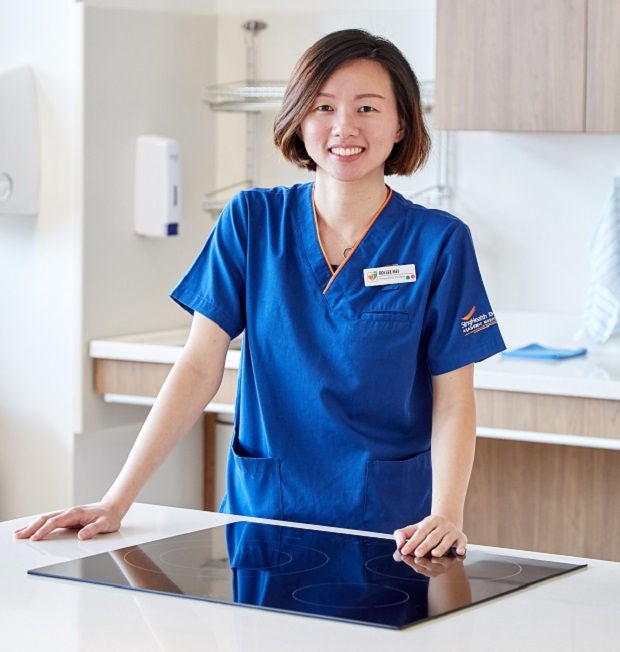
She remembers being enthralled as a teenager whenever she saw doctors in crisp white coats caring for people and saving lives in TV dramas, and always thought that working in a hospital was cool.
A friend introduced her to occupational therapy. “I thought it would be a meaningful career that will give me the opportunity to make a difference to patients even though I’m not a doctor,” said Ms Ooi Lee Mei, who, now after 10 years in the field, is a Senior Occupational Therapist at Outram Community Hospital (OCH).
The “occupation” in occupational therapy
In the newly opened community hospital, Ms Ooi helps patients who have been hospitalised for stroke, surgeries, falls, or illnesses get back on their feet — literally!
She meets about 16 patients with the help of a therapy assistant each day, to practise common daily activities with them, which would help them transit smoothly back to their normal lives after discharge.
A typical workday will see her helping patients move from bed to wheelchair, practise self-care tasks, such as showering, dressing, or other household activities like mopping the floor or cleaning the cupboard. She does this in a mock-up apartment in OCH, which comes complete with a kitchen, living room, bedroom, and other facilities.
“When I work with my patients, I am the bridge between them and the activities that they partly or totally cannot do anymore,” she said. The “occupation” in occupational therapy refers to just that — going back to the basic, routine activities of everyday life.
“We help them regain the ability to do the activities that are important to them. For some, it may be going back to their roles of a daughter, parent, or grandparent. For housewives, it could be performing their daily chores, such as marketing, cooking, and doing the laundry; or going back to their hobbies like dancing and doing crafts.”
From time to time, Ms Ooi also advises patients on the safety of their home environment before they are discharged. For hip fracture patients, she would ask them to check if their chairs or beds are too low, and recommend additional equipment where necessary.
Affinity with the elderly
Most of her patients are 65 years old and above, a demographic she discovered she had affinity with during her secondary school days when she visited a nursing home.
While many of her peers saw the visit as an excursion, she saw it as contributing back to the community, and thoroughly enjoyed the stint.
“I speak a bit of dialect so I was able to converse with the elderly patients, and they could relate to me easily. During that time, I learned much from the experiences they recounted, and how it was like living their golden years,” she said.
In her current role, she enjoys interacting with the elderly, listening to their stories and picking up nuggets of wisdom from them.
When asked what makes a good occupational therapist, Ms Ooi said, “You must have a heart for patients. They need to feel that you are listening to them and that you care about them.”
She thinks that showing genuine concern makes a big difference to these patients, and she is often inspired by their fortitude. She recalls an elderly stroke patient from her previous workplace who was full of positivity, despite living in an institution and not having a family or very much else in life.
“His attitude to life was uncommon and refreshing given his circumstances. He wasn’t bitter about his plight, always tried his best, and was grateful for every little thing,” she said. After his discharge, she and her ex-colleague would visit him occasionally on their own accord.
Her takeaway message from him was: “In life, we should be happy with whatever we have or strive for more without being resentful.”
She carries this positivity with her at work, especially on days when she feels physically or emotionally tired. During these times, a smile or “thank you” from patients really keeps her going.













 Get it on Google Play
Get it on Google Play